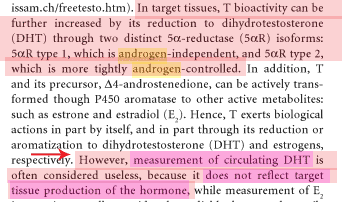BELOW: Further confirmation of the above (that 3alpha-diol G reflects 5ARII activity in both serum and tissue).
From epirev.oxfordjournals.org/cgi/reprint/23/1/42
"Dihydrotestosterone levels in tissue are several times
higher than the levels of testosterone, but serum levels of
dihydrotestosterone are only 10 percent of the serum levels
of testosterone because most dihydrotestosterone is produced
in tissue. In epidemiologic studies, serum levels of
3a-diol G are commonly used as an indirect measure of 5areductase
enzymatic activity, since it is not feasible to measure
tissue levels of testosterone and dihydrotestosterone in
cases and healthy subjects.
The current belief is that serum
levels of 3a-diol G reflect enzyme activities of both steroid
5a-reductase types 1 and 2.
[b]However, in studies of men
treated with finasteride, a 5a-reductase type 2 inhibitor,
serum levels of 3a-diol G decrease concomitantly with
finasteride treatment, suggesting that 3a-diol G levels predominantly
reflect the activity of the type 2 enzyme /b."


